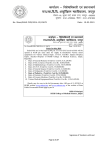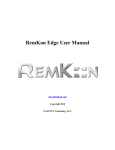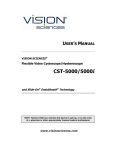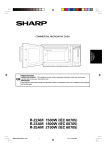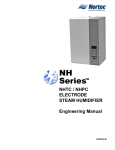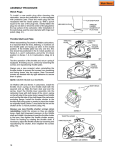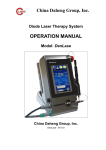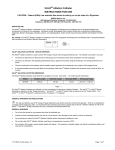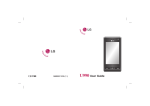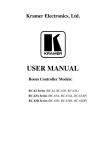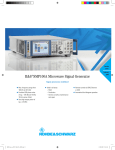Download 1 Contents Chapter 1 Introduction
Transcript
1 Contents Chapter 1 Introduction.......................................................................................................................................... 5 Introduction 6 How to Use This Manual 6 Symbols 7 Holmium Laser Theory of Operation 8 Laser Power Parameters 9 Energy Density 10 Unique Features of the Odyssey 30 B 10 System Specifications 11 Chapter 2 Installation...........................................................................................................................................13 Installation 14 Unpacking the Laser System 14 Component Checklist 14 Optional Accessories 15 Registering Your Laser System 15 Transportation and Storage Conditions 16 Electrical Requirements 16 Ambient Operating Conditions 17 Space Requirements 18 Initial System Power ON 18 Verifying Alignment and Calibration 19 Uninterruptable Power Supply 21 Chapter 3 Safety.....................................................................................................................................................23 Introduction 24 Optical Hazards 24 Electrial Hazards 25 Delivery System Related Hazards 25 Other Hazards 25 Safety Indicators 26 Labeling 26 2 Table of Contents Chapter 4 Fiber Optics.........................................................................................................................................31 Introduction 32 Care and Handling 32 Blast Shields 32 Choosing the Ideal Delivery System 33 Chapter 5 Indications...........................................................................................................................................35 Physician Training 36 General Information and Precautions 37 Urology 39 Chapter 6 Operation.............................................................................................................................................43 Introduction 44 Navigating the User Interface 44 User Power Settings Screen 44 Status Icons 45 User Options Screen 46 Power Matrices: 47 Preparation 49 Procedure Environment 49 Start-up Sequence 50 Adjusting the Screen Contrast 50 Setting Power Parameters 51 Treatment 52 Shut-down Sequence 52 Resetting the Emergency Stop 53 Chapter 7 Maintenance.......................................................................................................................................55 Preventive Maintenance 56 Other Regular Maintenance 56 Troubleshooting Error Codes 57 Troubleshooting Problems Without Error Codes 61 Blast Shield Maintenance 62 Inspecting the Blast Shield 62 Power Calibration 63 Odyssey 30 B User’s Manual 3 Table of Contents Chapter 8 Customer Service..............................................................................................................................65 Customer Service and Warranty 66 4 © 1999-2008 Xintec Corporation dba Convergent Laser Technologies. All rights reserved. Odyssey 30 B User’s Manual Cook Urological Document No. U_Ody30_EN_CE_REV1 No part of this manual may be reproduced, stored in a retrieval system, or transmitted in any form or by any means, electronic, mechanical, recording, or otherwise, without the prior written permission of Cook® Urological, Inc. The content of this manual is furnished for informational use only and is subject to change without notice. Odyssey 30, IQ Connector, and OptiLite are trademarks of Convergent Laser Technologies and Xintec Corporation. This product is protected by US Patent 4,950,268; 5,269,778; 5,689,520; other patents pending. Manufactured by: Cook® Urological, Inc. Cook® OB/GYN 1100 West Morgan Street Spencer, IN 47460 USA Printed in U.S.A. January 2008 Odyssey 30 B User’s Manual 0088 Cook Ireland LTD. O’Halloran Road National Technology Park Limerick, Ireland 5 1 Introduction 6 CHAPTER 1 Introduction Introduction The Odyssey surgical laser system and accessories are designed for use in the treatment of soft tissue disease and urinary stones. The laser system emits a concentrated beam of invisible radiation that may cause injury to the user or patient if improperly used. Prior to operating the laser system, the user and operating room personnel should be familiar with laser safety and the proper use of the laser system and its accessories. The user should carefully read and understand the contents of this Manual and accompanying documentation before using the laser to treat a patient. How to Use This Manual Chapter 1, “Introduction,” introduces the Odyssey laser system and its theory of operation. Chapter 2, “Installation,” outlines the procedure for site preparation and installation of the laser system. Chapter 3, “Safety,” provides information on regulatory compliance and the safe use of the laser system. Chapter 4, “Fiber Optics,” explains the delivery system and provides information for care and handling of fibers. Chapter 5, “Indications” provides the physician with precautions, indications, and contraindications related to the intended use of the laser system. Chapter 6, “Operation,” describes laser system controls and indicator signals. This chapter also outlines standard operating procedures. Chapter 7, “Maintenance,” provides maintenance procedures and a troubleshooting guide. Chapter 8, “Customer Service,” contains contact information for ordering accessories, obtaining warranty repair, or general service requests. Odyssey 30 B User’s Manual CHAPTER 1 Introduction Symbols The following table lists the symbols used on the laser system and within this Manual. The placement of the labels are diagrammed in Chapter 3. Additional symbols used on the touch screen interface are described in Chapter 6. ! Refer to Manual for additional instructions or warnings WARNING Dangerous voltage WARNING–Visible and invisible laser radiation STOP AP Non-AP equipment Type BF medical equipment Emergency Stop Alternating current MAINS ON isolation transformer energized MAINS OFF no power to entire laser system Key switch OFF isolation transformer may be energized Standby state Ready state Remote interlock Optical fiber applicator Foot switch laser activation device 7 8 CHAPTER 1 Introduction Holmium Laser Theory of Operation The Odyssey is a pulsed holmium YAG laser emitting laser radiation at 2100 nm. The holmium wavelength is highly absorbed by water making it superior for tissue ablation with minimal lateral thermal damage. In the case of laser lithotripsy, laser energy vaporizes water in the calculus causing it to crumble into smaller particles that pass easily through the urinary tract. A laser, an acronym for Light Amplification by Stimulated Emission of Radiation, produces a highly concentrated beam of light of a given wavelength. In contrast, white light, such as sunlight, is composed of light throughout the electromagnetic spectrum—from ultraviolet (UV), through visible light (i.e. the rainbow), to infrared (IR). Laser energy is generated by converting electrical energy to light energy using a flash lamp. The flash lamp energy is then used to excite the lasing medium, in this case a holmium YAG laser rod. The laser energy is amplified in the laser resonator cavity and a small portion of the energy is allowed to leak out. This becomes the working laser beam. The Odyssey is a flash lamp pumped solid-state laser. The flash lamp converts electrical energy to optical energy and the resonator mirrors amplify the optical energy. Output Coupler Mirror High Reflector Mirror Holmium YAG Laser Rod Odyssey 30 B User’s Manual Flash Lamp Working Beam, 2100nm CHAPTER 1 Introduction 9 Laser Power Parameters Lasers are useful in medical applications because of selective absorption of their energy by tissue. Since a laser emits light energy at a distinct wavelength, a laser wavelength is chosen that best matches the desired absorption characteristics for the target tissue. In general, holmium lasers (2100 nm) are better at ablating tissue than Nd:YAG lasers (1064 nm) because the holmium wavelength is readily absorbed by water, which constitutes a major portion of tissue. However, the Nd:YAG wavelength transmits easily through water, making it more suitable for coagulation and for generating thermal effects. The erbium laser (2940 nm) is superior at ablation, but the lack of commercially available fiber-optics makes it unsuitable for endoscopic procedures. Power Pulse Peak Power [W] Pulse Duration [µs] Pulse Energy [J] Water Absorbtion Coefficient (log 10) Er:YAG Ho:YAG Nd:YAG 1064 2940 2100 Laser Wavelength (nm) Though laser wavelength is the primary governing factor in tissue interaction, the mode of laser delivery, or power parameter, determines its clinical effectiveness. For pulsed lasers like the Odyssey, the mode of laser delivery depends on the pulse peak power, energy density, pulse duration, and repetition rate. Most pulsed laser systems are rated by their highest attainable average power. Average power (P, measured in Watts) is calculated by multiplying the pulse energy (E, measured in Joule per pulse) with the repetition rate (f, measured in pulses per second or Hz). For example, the Odyssey 30 is capable of delivering 3.0 J/pulse at 10 Hz making it a 30 Watt laser system. Note that useful laser power should be measured at the operating plane and not out of the laser resonator cavity. A laser’s water absorption characteristics coupled with the mode of laser delivery governs its clinical efficacy. 10 CHAPTER 1 Introduction Energy Density Energy density is one of the most important laser operating parameters for safe and effective laser surgery. Energy density is proportional to the pulse energy and inversely proportional to the square of the beam diameter. For example, switching from a 400 µm (micron) core fiber (0.4 mm) to a 200 µm (micron) core fiber (0.2 mm) results in an energy density that is four times greater than before. The selection of appropriate power parameters is dependent on the procedure, the selection of delivery system, and the specific conditions of the patient. Before using the laser system on a patient, the user should have attended a training course on the specific procedure and have consulted fellow physicians on the latest clinical techniques, indications, and contraindications. energy density [J/cm2] ∞ pulse energy [J] beam diameter [µm]2 Unique Features of the Odyssey 30 B • Controlled Delivery—Microprocessor controlled delivery insures precise power delivery and pulse-to-pulse uniformity. • Ease of Use—Touch screen user interface reduces the number and type of controls to a bare minimum. A status line at the bottom of the screen alerts the user in the event of a safety hazard or system error. Motorized blast shield facilitates blast shield changes without removing any access panels. • 273 µm Fiber Capable—Specially designed optics and mounts allow laser energy to be delivered into a straight 273 µm core fiber without the need for expensive tapered fibers. • Variable Pulse Duration—Allows the user to easily change the mode of laser delivery and shift between ablative or coagulative tissue effects. • Safety—A safety monitor continuously monitors every subsystem and automatically sets the laser system to Standby state in the event a potential hazard is detected. Odyssey 30 B User’s Manual CHAPTER 1 Introduction System Specifications Model Laser Type Laser Wavelength Maximum Output Power1 2100 nm 30 W 1.14 to 7.1 KW Pulse Duration 350 or 700 µs Pulse Energy 0.4 to 3.0 J Repetition Rate 5 to 20 Hz Laser Output Nominal Ocular Hazard Distance Visible Aiming Beam 25° cone angle Gaussian 5.64in (14.33cm) Variable intensity 3 mW green, 532 nm Laser Activation Foot switch Cooling System Self-contained water-to-air Physical Dimensions Weight 102 cm H x 40 cm W x 84 cm D (40” H x 16” W x 33” D) 90 Kg (200 lb) Electrical Requirements2 115/230 V~ 50/60Hz Regulatory Compliance US CFR 1040.10, 1040.11 Safety Compliance 2 Pulsed CTH:YAG (holmium:YAG) Pulse Peak Power Beam Divergence 1 Odyssey 30 UL/CSA 2601, EN 60601-1-1, EN 60825-1, EN 60601-2-22, EN 60601-1-2 (EMC) 30 W average power achievable with 230 V~ input and 550 µm core fiber. See Chapter 2 for more complete electrical requirements. 11 12 CHAPTER 1 Introduction This page intentionally left blank. Odyssey 30 B User’s Manual 13 2 Installation 14 CHAPTER 2 Installation Installation The Odyssey laser system, and any uninterruptable power supply (UPS) used in conjunction with the laser system, should be installed in a way that optimizes its usability. Unpacking the Laser System Your Odyssey laser system is shipped from the factory in a wooden crate to protect the laser system from damage during shipping. Before uncrating, inspect the crate for damage. If there is evidence of damage, save all packing materials and notify the shipping company by filing an insurance claim report. After the laser system has been unpacked, please store the shipping crate and packing materials in a safe location in case the laser system has to be transported in the future. Component Checklist The Odyssey laser system is delivered with the following components or accessories. Please take inventory of the below items and ensure that there are no missing items. • Odyssey 30 B laser system • User’s manual • Product performance certificate • Dust cover • Detachable power cord with NEMA L6-30P plug (for 230 VAC) or NEMA L5-15P (for 115 VAC). • Detachable foot switch • Remote interlock connector (attached to laser system) • 2 operation keys • 600 µm core test fiber assembly with flat tip Odyssey 30 B User’s Manual CHAPTER 2 Installation Optional Accessories The following list includes the most common accessories used with the Odyssey. Please refer to Cook’s product catalog for additional information and pricing. HLA-2000 Holmium Laser Radiation Warning Sign HLA-2010 Holmium Laser Safety Glasses HLA-2020 Holmium Laser Safety Goggles HLF-S273-CNV 273 µm single use laser fiber with flat tip HLF-S365-CNV 365 µm single use laser fiber with flat tip HLF-S550-CNV 550 µm single use laser fiber with flat tip HLF-S940-CNV 940 µm single use laser fiber with flat tip HLF-M273-CNV 273 µm multi-use laser fiber with flat tip HLF-M365-CNV 365 µm multi-use laser fiber with flat tip HLF-M550-CNV 550 µm multi-use laser fiber with flat tip HLF-M940-CNV 940 µm multi-use laser fiber with flat tip Registering Your Laser System Please be sure to register your laser system with your local distributor. Please include the serial number of your laser system when contacting them. By registering your laser system, you will be notified of product safety bulletins and updates to the software and documentation. 15 16 CHAPTER 2 Installation Transportation and Storage Conditions In transit the laser system must be packaged to protect the enclosures from damage; such as in the original shipping crate. If the original shipping crate is not used for transportation the system must be secured to prevent damage. The handles can be used to tie the system to a secure surface; the enclosure should NOT be used for this purpose. The enclosures should not be subjected to excessive force, shock or vibration. If shock or vibration are suspected the laser alignment should be inspected by a trained technician. If any water remains in the cooling system the laser must not be subjected to freezing temperatures. Storage and transit temperature must not exceed 43° C (110°F). Storage humidity should not exceed 95%. If the laser is stored in a high humidity location it must be allowed sufficient time to reach equilibrium when introduced to a cool operating environment. Failure to do this may result in damage to the optics from condensation. Electrical Requirements The Odyssey is equipped with a worldwide tappable isolation transformer, which can be configured to suit your line voltage conditions. The laser system will perform optimally if it has its own dedicated, stable electrical supply line. Measure the alternating current (“AC”) line voltage with and without load to verify that the electrical supply line is stable. Please contact customer service to request the technical bulletin on reconfiguring the transformer. DANGER—High Voltage—Only a qualified service technician or biomedical engineer can reconfigure the isolation transformer. A mistapped transformer may cause serious harm to the technician and/or damage the laser system. Nominal Outlet Voltage 115 V~ 230 V~ Voltage Range 103-127 V~ 207-253 V~ Current Rating 15 A 15 A Maximum Output Power 15 W 30 W Odyssey 30 B User’s Manual CHAPTER 2 Installation The maximum output power is dependent on the line voltage. When the input voltage is 115 V~, the software limits the output power to 15 W. At 230 V~, the laser system is capable of delivering full power. Ambient Operating Conditions The laser system should be used in a well-ventilated, air-conditioned operating room. The procedure room temperature should be kept between 18-22° C (65-72 °F) for optimum system performance. In general, Holmium lasers are very sensitive to temperature, so the output can vary by up to 15% depending on the room temperature. The laser system is factory calibrated at 21° C (70°F). When the laser system reaches above 38° C (100 °F), the safety circuits will prevent the laser system from operating. The touch screen status readout will display “11: System Overheat.” The laser system overheats for the following reasons: • the ambient operating room temperature is above 24° C (74 °F) , • the laser system has been running at high power for an extended period of time (greater than 20 minutes), or • the input line voltage is lower than normal causing the cooling fans or water pump to under-perform. 17 18 CHAPTER 2 Installation Space Requirements The laser system requires adequate space to reduce potential operating hazards and allow for proper air ventilation. The cooling system contains two radial fans located at the bottom of the laser system. Cooling air is drawn from the bottom of the unit and exhausted through the vents located on the right, left, and back sides of the laser system. There should be a clearance of at least 1 meter (3 ft) on each side of the system to allow for proper airflow. Allow about 1 meter on all sides of the laser to allow for adequate ventilation. Top View Front 1m Rear ! To reduce potential operating hazard, the laser system should be positioned at least 1 meter (3 ft) from the patient. The procedure room should be in a controlled access area. If necessary, install the remote interlock switch to prevent inadvertent laser exposure to unsuspecting personnel entering the operating room. A laser danger sign must be posted on each operating room access door. Please consult your Laser Safety Officer for applicable laser safety procedures. Initial System Power ON Review the previous sections in this chapter and verify that all site installation requirements have been met. The laser system should only be operated in a restricted access area. Post a laser danger sign on each access door. 1 Plug the detachable power cord into the laser system. Odyssey 30 B User’s Manual CHAPTER 2 Installation 19 2 Verify that the MAINS switch is in the OFF (O) position. 3 Verify that the key switch is in the OFF (O) position. 4 Plug the outlet end of power cord to a suitable electrical outlet. 5 Verify that the remote connector is secured. 6 Plug the detachable foot switch into the connector on the back panel. 7 Raise the fiber mast to the upright position. 8 Turn ON (I) MAINS switch. 9 Turn ON (I) the key switch. The yellow Standby LED is lit. After 5 seconds, the touch screen displays the user power settings screen. 10 Lift the laser aperture door and insert the 600 µm test fiber into laser aperture. Do not overtighten the delivery system connector. The connector only needs to be finger-tight for proper operation. 11 After about 5 seconds, the touch screen status displays “STANDBY” and an icon appears on screen indicating that a 600 µm core fiber has been properly connected. 12 Press the Ready button. The green Ready LED is lit. 13 The touch screen status displays “Please Wait ...” 14 If the touch screen status displays “READY” after 2 seconds, then the system is operating normally. If not, please consult the troubleshooting guide in Chapter 6 or call for service. 15 Follow the instructions in the next section to verify the alignment and calibration. Verifying Alignment and Calibration The laser system has been designed with many safeguards to prevent optical misalignment due to shipping and normal operation. However it is important to verify the alignment and calibration of the laser system to ensure peak system performance. ! 20 CHAPTER 2 Installation The following test requires a calibrated energy or power meter. Please contact your distributor if you would like to know if your energy or power meter is compatible with the Odyssey. ! The test below is intended for laser systems operating at 230 V~ nominal. Skip step 12 if you are operating the laser system using a 115 V~ electrical outlet. 1 Setup laser system for lasing. 2 Verify that the 600 µm test fiber has clean surfaces on both the connector and distal ends. 3 Insert the 600 µm test fiber into the laser aperture. 4 Wear appropriate safety eyewear. See Chapter 3. While the laser is in operation, all personnel in the operating room must wear appropriate laser eyewear. The working beam is invisible and can cause irreparable eye damage. Do not stare into the beam, even through laser eyewear. 5 Setup energy/power meter probe in front of and parallel to the distal face of the test fiber. Be careful not to place the fiber tip too close to the probe as the energy density may damage the probe’s sensitive surface. Do not place the distal tip of the fiber too close to the probe as the high energy density may destroy the probe’s sensitive coatings. Measuring Plane Fiber Distal End 3-6 cm 6 Set the power parameters to 350 µs, 7 Hz, 0.5 J (3.5 W). 7 Press the Ready button and wait 2 seconds. 8 Depress the foot switch for 5-10 seconds until you get a stable reading on your energy/power meter. 9 If the power reading is not within 10% of the displayed power, the laser system is either misaligned or out of tune. Please call for service. Odyssey 30 B User’s Manual CHAPTER 2 Installation 21 10 Repeat steps 7-9 for 350 µs, 10 Hz, 1.5 J (15 W). 11 Inspect connector end of fiber for burn marks. If there is a burn mark, the laser system is out of tune. Please call for service. 12 (230 V~ systems only) Repeat steps 7-9 & 11 for 350 µs, 10 Hz, 3.0 J (30 W). 13 Follow instructions in Chapter 6 to shut down the laser system. If you receive an under-power warning message, the most likely cause is that the resonator mirrors are slightly out of alignment. The laser will continue to operate normally. Call for service at next opportunity. Uninterruptable Power Supply (UPS) Consult the UPS users manual for information on safe installation. Ensure that the UPS is safely installed prior to use with the laser system. ! 22 CHAPTER 2 Installation This page intentionally left blank. Odyssey 30 B User’s Manual 23 3 Safety 24 CHAPTER 3 Safety Introduction This chapter contains important safety information related to the use of the laser system. All operating room personnel should familiarize themselves with the contents of this chapter before operating or assisting in the operation of the laser system. All efforts have been made to minimize hazardous conditions during system design. However, since the laser system is high power equipment, it is impossible to eliminate all potential hazards that may result in user and patient injury. The Odyssey is classified as a Class IV laser system by the National Center for Devices and Radiological Health (CDRH). Class IV represents the highest class of laser devices. Laser energy should only be applied to the intended treatment area. ! Read this manual carefully. The performance of procedures, controls or adjustments other than those specified herein may result in hazardous radiation exposure. Optical Hazards • All persons in the operating room must wear appropriate safety eyewear while the laser is in operation. Appropriate eyewear includes safety spectacles and goggles with an Optical Density of 4 or greater. • The working beam is invisible and can cause irreparable eye damage. Only direct the optical fiber at the intended surgical site. • Eye damage can occur not just by direct viewing of the working beam but also through scattered laser radiation when reflected off smooth surfaces such as operating room walls, floors, and other surgical equipment. • Do not look directly at the distal end of the optical fiber or into the laser aperture. Odyssey 30 B User’s Manual CHAPTER 3 Safety Electrical Hazards • Only a qualified service technician may remove the enclosure covers. Removing the enclosures exposes personnel to potential electrical hazards. There are no user-serviceable parts within the laser system. • Do not touch areas marked HIGH VOLTAGE. These and surrounding components in the laser system contain charge voltages of up to 1000 VDC. • Do not operate the laser system or the UPS if the procedure room floor is flooded. Delivery System Related Hazards • The use of incorrect or broken fibers may result in injury to the user or the patient due to inadvertent laser exposure. • The use of incorrect, damaged or soiled fibers may result in damage to the laser system (blast shield and output lens) and to the endoscope in use. • Check fibers regularly for damage. See Chapter 4 for more information. Other Hazards • RISK OF FIRE—Do not direct the distal end of the fiber on flammable materials such as surgical drapes. • RISK OF EXPLOSION—Do not operate the laser system in the presence of flammable substances including flammable anesthetics. • Electromagnetic Interference—There is a risk of interference when the laser is used in conjunction with other electronic devices. Use of an Uninterrupted Power Source (UPS) is required to comply with IEC 60601-1-1. Specifically, regulations require the use of the Smart UPS-3000, made by APC, or a unit which has the same funtionality and appropriate medical certifications and approvals. • Unauthorized Use—The laser system is designed to be used and serviced by trained individuals. To protect against damages from unauthorized use remove the key from the key switch and make it available only to qualified technicians and operators. 25 26 CHAPTER 3 Safety Safety Indicators ! ! • Standby yellow LED, located on the Standby button on the control panel, indicates that the laser system is in Standby state. Depressing the foot switch will NOT activate the laser. • Laser Ready indicator green LED, located on the Ready button on the control panel, indicates that the laser system is in Ready state—no system errors are present and the touch screen is displaying the user power settings screen. Depressing the foot switch will activate the laser. When switching from Standby state to Ready state, there is a two second delay to allow time for laser operator to give adequate notice to operating room personnel. • Capacitor charge indicator icon, located on the lower right corner of the touch screen display, indicates whether the main capacitor bank has no charge, is half charged, or is fully charged. • Audible emission warning alerts operating room personnel that the laser is firing. • Visible emission indicator (blinking amber LED), indicates that the laser is firing. The audible and visible emission indicators operate simultaneously. • Status readout, located on the lower left corner of the touch screen display alerts the user of any internal system errors. The error codes are referenced in Chapter 7. In the event of a system error, the laser system will immediately return to Standby state and the Status readout will display a corresponding error code. Labeling The Odyssey contains all appropriate labels to satisfy U.S. Food and Drug Administration (FDA), Underwriter’s Laboratory (UL), European Union (CE), and Canadian Standards Assocation (CSA) medical laser device labeling requirements. Odyssey 30 B User’s Manual CHAPTER 3 Safety Visible emission indicator— blinks when laser is operating Laser ready indicator— laser ready to fire when green LED is lit READY Ready button— set laser system in Ready state STAND BY Standby button— sets laser system in Standby state LASER APERTURE laser aperture—laser radiation is emitted from this aperture laser aperture door UP: open position laser aperture door lever laser aperture door DOWN: closed position fiber-optic connector port LASER TECHNOLOGIES Odyssey 30 B Front View 27 28 CHAPTER 3 Safety STOP Emergency Stop—hit the emergency stop to cut all electrical power to the laser system. ! DANGER VISIBLE & INVISIBLE LASER RADIATION WHEN OPEN AND INTERLOCKS DEFEATED AVOID EYE OR SKIN EXPOSURE TO DIRECT OR SCATTERED RADIATION STOP 40W MAX AT 2100nm 3mW MAX AT 532nm CLASS 4 LASER PRODUCT CONFORMS TO IEC 60825-1:1993+A1:1997 (located on the lower right side door) Odyssey 30 B Top View Odyssey 30 B User’s Manual CHAPTER 3 Safety top panel lock Key switch Access to dangerous voltages if top panel is removed CAUTION REMO REMOTE INTERLOCK ! INTERLOCK REMOTE INTERLOCK FOOT SWITCH Mains: 115/230 115/230V~50/60 Hz, 15A Manually configured FOOT SWITCH Model No.: Odyssey 30 Serial No.: 29020.0001 Manufactured: August 1999 ! See Chapter 2 for electrical requirements CONVERGENT LASER TECHNOLOGIES Mains: 115/230 V~ 50/60 Hz, 15 A Manually configured AP Model No.: Serial No.: Manufactured: Odyssey 30 29020.0001 August 1999 DANGER–Risk of explosion if used in the presence of flammable anesthetics MAINS switch Type BF Equipment This product complies with 21 CFR 1040.10 and 1040.11 as applicable. This product is protected by US Patent Nos 4,950,268; 5,269,778; 5,689,520; other patents pending. CONVERGENT LASER TECHNOLOGIES 1660 South Loop Rd, Alameda CA 94502 Made in the U.S.A. MAINS appliance inlet AP DANGER–Risk of explosion if used in the presence of flammable anesthetics Type BF Equipment This equipment is designed to provide an adequate degree of protection against electric shock, particularly regarding allowable leakage currents and reliability of the protective earth connection. Odyssey 30 B Back View 29 30 CHAPTER 3 Safety The following labels are found inside the laser system. Only a certified technician is authorized to remove the enclosures. ! DANGER Visible and invisible laser radiation when open and interlocks defeated. AVOID EYE OR SKIN EXPOSURE TO DIRECT OR SCATTERED RADITION. Class 4 laser product. • This explanatory label is located on the cover of the optical platform and on the resonator chamber. When these interlocked covers are removed, hazardous laser radiation may be emitted from the laser head into the operating room. • Access to this panel is restricted to authorized service personnel. • This label indicates dangerous voltage. Systems bearing this label must be accessed with caution. • These systems include the AC Distribution System and the High Voltage Capacitor Bank. • This label indicates a ground connection. • Low Voltage Power Supply and the AC Inlet/MAINS are connected to the chassis. Odyssey 30 B User’s Manual 31 4 Fiber Optics 32 CHAPTER 4 Fiber Optics Introduction Your Odyssey Laser System is designed for use with Cook OptiLite optical fibers exclusively. The use of any alternative delivery system may result in user or patient injury, or damage to the laser system and will void the warranty (see Chapter 8). The delivery system affects the patient, the user, and the laser system and therefore must be treated with care. Care and Handling All optical fiber assemblies are fragile. While smaller fibers are more flexible, all sizes are prone to fracture. Do not bend fibers to a diameter of 5 inches (12.7cm) or less. Do not apply excessive pressure. Use of broken fibers may cause injury to the system or the patient. Ensure the integrity of the delivery system prior to use. Using the aiming beam or an HLA2300 Fiber Inspection Microscope, check for any light escaping along the length of the fiber or for unusual dimness from the distal end. The connector end of the fiber assembly is also fragile, and must be kept clean. Any dust, dirt, oil, or scratches on the connector can cause costly damage to the laser. Never touch the connector surface with bare hands. Do not use a fiber if the connector may be soiled or damaged. Always replace the connector cap when the fiber is not connected to the laser system. The distal end is sharp and will damage articulating endoscopes if not threaded through carefully. Extend the distal end of the fiber through the working channel of the endoscope only when the endoscope is straight. If the endoscope must be articulated to visualize the calculus, straighten it to extend the distal end of the fiber through. Then articulate the endoscope to bring the calculus back into view. Blast Shields Each Odyssey Laser is equiped with a disk of six blast shields which protect the output lens from flash back debris. Normally, each blast shield should last over 100 cases, but they can be easily damaged by using dirty, scratched or inapropriate delivery systems. Continued use of a soiled blast shield will damage the output lens. Odyssey 30 B User’s Manual CHAPTER 4 Fiber Optics Damaged fibers can be both a cause and a symptom of a soiled blast shield. If a fiber is suspected to be damaged after use with the laser, rotate the blast shield disk (see Chapter 7) and alert a technician that a blast shield may be soiled. Choosing the Ideal Delivery System Cook OptiLite delivery systems come with 273, 365, 550, or 940 µm core diameters. Larger cores will provide more power, but are less flexible. Users are encouraged to select the largest core feasable considering the flexibility needed to reach the target, and the size of the endoscope’s working channel. 33 34 CHAPTER 4 Fiber Optics This page intentionally left blank. Odyssey 30 B User’s Manual 35 5 Indications 36 CHAPTER 5 Indications Physician Training Physician training should include all of the following areas, which are often performed chronologically in the order listed below: 1 The physician should thoroughly review published literature related to the holmium laser procedures. These include literature pertaining to general laser biology and specific treatment techniques for a particular disease entity. The physician should also review similar modalities in related specialties and similar indications using other types of lasers such as Nd:YAG, Er:YAG and CO2 wavelength lasers. 2 The physician should attend training courses and seminars at medical conferences related to holmium laser procedures. At these conferences, there are a number of courses on laser therapy which discuss the latest surgical techniques, precautions, indications, and contraindications. 3 The physician should attend hands-on workshops offered at medical conferences or available in your local area. 4 The physician should attend didactic courses that include both seminar and laboratory sessions. 5 Where possible, the physician should visit other physicians who are performing similar or related laser therapy to observe cases and discuss different aspects of the procedures. Odyssey 30 B User’s Manual CHAPTER 5 Indications General Information and Precautions Indications The Odyssey laser system and accessories are intended solely for use by properly trained and qualified physicians. The laser system is indicated for use in urology. The use of the laser system for an application is at the physician’s discretion except in cases where contraindicated. Warnings • Unexpected or uncontrolled tissue damage can sometimes occur due to excessive power application. Use only the lowest pulse energy settings required to achieve the desired tissue effects. Extreme caution should be employed until the biological interaction of the laser energy with tissue is fully understood by the physician. • As with conventional endoscopic and laparoscopic treatment, the possibility of adverse reactions such as chills, fever, edema, and hemorrhage may occur following treatment. In extreme cases, death may occur either due to procedural complications, concurrent illness, or laser application. Precautions Use caution with patients who have had difficulty with previous endoscopic or laparoscopic procedures. • • The laser should be used only on a tissue target that is fully observable either by direct sight or through an endoscope. • Vaporization or excision of anatomical structures in proximity to known critical structures such as large arteries, veins, bowel, ureter, bladder, etc. should be performed carefully to avoid damage to such structures. • Electrocautery should be easily accessible in the event that a bleeding artery or vein needs to be cauterized. • The flammability of methane gas must be considered when treating in the perianal area. Clinical Parameters • The holmium laser wavelength (2100 nm) has been shown to be a safe and effective tool for ablation, excision, and coagulation of a variety of soft tissues as demonstrated by numerous clinical studies and pre-clinical experience. The depth of laser incision is dependent on the power parameters (see Chapter 1). 37 38 CHAPTER 5 Indications The rate of incision is dependent on the pulse frequency or repetition rate. Optimum incision of tissue is accomplished by balancing the depth and rate of the incision being formed. • If a surgical probe is used in contact mode with the tissue, the localized heating may cause the distal end of the fiber to deform. • Please consult the specific sections of this chapter for additional clinical information. The most up-to-date clinical indications can be collected through the sources listed in the Physician Training section of this chapter. Usage Recommendations • The holmium laser wavelength is strongly absorbed by water and is generally considered as an effective tool for tissue ablation with minimal lateral thermal damage. ! • When the surgical probe is used in non-contact mode, the working beam is diverging at approximately 25°. The energy density decreases as the distal tip moves further from the target tissue (see Chapter 1). Approximately 2-30% of the working beam may be lost to backscatter of which a portion may be absorbed by non-targeted peripheral tissue. • When using the surgical probe in contact mode, place the distal tip in contact with tissue before activating the laser. Discontinue power delivery as the fiber tip is being disengaged from the tissue to minimize the adhesion of tissue to the fiber tip. • When selecting power parameters, always select the lowest power parameters to achieve the desired tissue effect. Start with the lowest reasonable setting and gradually increase power if necessary. See Chapter 6 for power selection methodology. • When using the laser within a non-aqueous environment a method of plume and fume extraction must be considered. Laser plume may contain viable tissue particulates. Odyssey 30 B User’s Manual CHAPTER 5 Indications Urology Indications Incision, excision, coagulation, ablation, therapeutic thermal or photodisruption of all tissue and treatment of tumors and stones in the genitourinary tract, and specifically for the fragmentation of upper and lower tract urinary calculi including cystine, calcium oxalate, monohydrate, and calcium oxalate dihydrate stones. Warnings • Extreme caution should be used until the physician is completely familiar with the biological interactions of laser with various tissue types. • Do not operate the laser if the operating plane is not visible either by direct sight or via an endoscope. • Steady the distal end of the fiber at the intended treatment target before depressing the foot switch. • Tissue perforation can occur if excessive laser energy is applied, whether through excessive pulse energy or extended laser application dwell time. Because fiber tips are sharp, perforation may occur by mechanical means (poking). • When risk of air embolism is present, such as cutting/vaporizing organs with large vascular structures, always use fluid cooling. • Screen tumors that are in close proximity to known arteries or veins by pretreatment workups to precisely locate the tumors. • The risk of combustion, perforation, and laser-induced hemorrhage, any of which can cause patient death, must be fully explained to the patient prior to surgery. • Endoscopic treatment may result in adverse reactions such as fever, chills, sepsis, edema, and hemorrhage. In extreme cases, death may occur due to procedural complications, concurrent illness, or the application of laser radiation. Precautions • Use caution when treating patients who have had difficulty with previous endoscopic procedures. • When radiotherapy and laser therapy are used concurrently, extra precautions should be taken including conducting more stringent postoperative 39 40 CHAPTER 5 Indications monitoring. Patients who have undergone radiotherapy present a greater risk of perforation and tissue erosion. • Cook® Medical has no clinical information or experience concerning the use of the Odyssey on pregnant women or nursing mothers. • Patients who have experienced discomfort during previous laser treatment may require analgesics. Complications & Risks The following complications can cause patient death: • Non-thermal—Perforation, aspiration, induced hemorrhage, allergic reaction to medication, hypertension, arrhythmia, pain, gas over-distention, pneumothorax, and infection. Thermal Acute—Induced hemorrhage, ulceration, perforation, edema, pain, fever, leukocytosis, and chills. Thermal Chronic—Delay in healing, perforation, delayed hemorrhage, and sepsis. • Pain—Short-lived pain may occur immediately following endoscopic laser therapy and may persist for as long as 48 hours. • Fever & Leukocytosis—Immediately after laser therapy, the patient may experience fever and leukocytosis, which are commonly associated with tissue destruction. These conditions are generally resolved without treatment. Tissue cultures are indicated to exclude the possibility of infection. • Bleeding—Patients may experience bleeding at the surgical site or from erosion of a tumor during or after laser therapy. Post treatment blood studies, such as hematocrit levels, may be necessary. • Sepsis—Laser-ablated tissue may become infected after therapy. If a question of sepsis exists, a culture should be taken and other appropriate evaluations made. • Perforation—Perforation can occur as a result of excessive exposure to laser radiation. Perforation can also occur from tumor erosion, or as a result of endoscopic or cystoscopic procedures. To clinically diagnose perforation, patients must be monitored postoperatively through physical signs, hematocrit, and radiography. Odyssey 30 B User’s Manual CHAPTER 5 Indications • Gas Over-distention & Pneumothorax—Patients may experience gastrointestinal distension or pneumothorax during or after therapy. Contraindications The use of the holmium laser is contraindicated for patients: • who are inappropriate candidates for laser surgery • who are intolerant of anesthesia 41 42 CHAPTER 5 Indications This page intentionally left blank. Odyssey 30 B User’s Manual 43 6 Operation 44 CHAPTER 6 Operation Introduction The Odyssey laser system user interface is feature-rich and intuitive. The touch screen display allows you to precisely control your laser parameters. The laser system is intended for use only by physicians trained in the therapeutic use of holmium lasers. Before operating the laser, the user should be familiar with the safety precautions noted in Chapter 3 and the clinical indications noted in Chapter 5. In addition, all operating room personnel should be trained in laser safety. touch screen interface All user controls are accessible through the control panel and touch screen interface. laser ready indicator Standby button STANDBY READY Ready button Navigating the User Interface The user mode touch screen interface is separated into two screens: user power settings screen and user options screen. All necessary operating controls are located on the user power settings screen. To prevent inadvertent laser exposure, the laser system can only lase when the touch screen is displaying the user power settings screen and the laser Ready indicator is ON (lit green). User Power Settings Screen AIMING BEAM Visible aiming beam brightness control • defaults to OFF in Standby state and defaults to ON in Ready state • • • PULSE WIDTH 350 µs Odyssey 30 B User’s Manual adjustable in 10 step increments lowest step is OFF touch UP to turn ON beam while in Standby mode. Pulse width (pulse duration) control • toggle between 350 µs and 700 µs CHAPTER 6 Operation AVG POWER 4.9 Energy control • increase or decrease pulse energy in 0.1 J increments W REP RATE ENERGY 7 Hz 0.7 J Repetition rate control • increase or decrease the pulse repetition rate Average power display • average power calculated by multiplying rep rate (pulse frequency) with pulse energy STATUS Standby Status display • under normal conditions, displays the operating state of the system: STANDBY or READY • under error state, displays the error identification number COUNTER 00000 Joule counter • displays the total amount of energy delivered • reset button sets the counter back to zero User options screen button • jump to user options screen Status Icons Input line voltage indicator 115V 115 V~ line input (also used for 100 V~) 230V 230 V~ line input (also used for 200 V~) Delivery system indicator no delivery system connected 200 273 µm fiber assembly connected 400 365 µm fiber assembly connected 600 550 µm fiber assembly connected 1000 940 µm fiber assembly connected 45 46 CHAPTER 6 Operation Capacitor charge indicator capacitor voltage between 0 and 50 (no icon) capacitor voltage between 50 and 400 V capacitor voltage between 400 and 600 V capacitor voltage between 600 and 1000 V User Options Screen System information • system serial number INFO Serial No. 29020.000 Version No. V2.19.0 Manufactured January 2008 • • COOLANT TEMP. 70 °F 21 °C SCREEN CONTRAST BLAST SHIELD 3 ! software version number date of manufacuture Coolant temperature display • displays the cooling water temperature in degrees Fahrenheit and Celsius Screen contrast adjustment • increase or decrease the touch screen contrast Blast Shield control • advance or reverse blast shield disk position between positions 1 through 6 Unless the Blast Shield is inadvertantly rotated forward, only a trained service technician should rotate the disk in reverse. Return button • Odyssey 30 B User’s Manual return to the user power settings screen CHAPTER 6 Operation Power Matrices: Bolded numbers are for use in calibration. 350 µs pulse width (power in W) 5 Hz 7 Hz 10 Hz 12 Hz 15 Hz 20 Hz 0.4 J 2.0 2.8 4.0 4.8 6.0 8.0 0.5 J 2.5 3.5 5.0 6.0 7.5 — 0.6 J 3.0 4.2 6.0 7.2 9.0 — 0.7 J 3.5 4.9 7.0 8.4 10.5 — 0.8 J 4.0 5.6 8.0 9.6 12.0 — 0.9 J 4.5 6.3 9.0 10.8 13.5 — 1.0 J 5.0 7.0 10.0 12.0 15.0 — 1.1 J 5.5 7.7 11.0 13.2 16.5 — 1.2 J 6.0 8.4 12.0 14.4 18.0 — 1.3 J 6.5 9.1 13.0 15.6 19.5 — 1.4 J 7.0 9.8 14.0 16.8 21.0 — 1.5 J 7.5 10.5 15.0 18.0 22.5 — 1.6 J 8.0 11.2 16.0 19.2 — — 1.7 J 8.5 11.9 17.0 20.4 — — 1.8 J 9.0 12.6 18.0 21.6 — — 1.9 J 9.5 13.3 19.0 22.8 — — 2.0 J 10.0 14.0 20.0 24.0 — — 2.1 J 10.5 14.7 21.0 25.2 — — 2.2 J 11.0 15.4 22.0 26.4 — — 2.3 J 11.5 16.1 23.0 — — — 2.4 J 12.0 16.8 24.0 — — — 2.5 J 12.5 17.5 25.0 — — — 2.6 J 13.0 18.2 26.0 — — — 2.7 J 13.5 18.9 27.0 — — — 2.8 J 14.0 19.6 28.0 — — — 2.9 J 14.5 20.3 29.0 — — — 3.0 J — — 30.0 — — — 47 48 CHAPTER 6 Operation 700 µs pulse width (power in W) ! 5 Hz 7 Hz 10 Hz 12 Hz 15 Hz 0.4 J 2.0 2.8 4.0 4.8 6.0 0.5 J 2.5 3.5 5.0 6.0 7.5 0.6 J 3.0 4.2 6.0 7.2 9.0 0.7 J 3.5 4.9 7.0 8.4 10.5 0.8 J 4.0 5.6 8.0 9.6 12.0 0.9 J 4.5 6.3 9.0 10.8 13.5 1.0 J 5.0 7.0 10.0 12.0 15.0 1.2 J 6.0 8.4 12.0 14.4 — 1.3 J 6.5 9.1 13.0 15.6 — 1.4 J 7.0 9.8 14.0 16.8 — 1.5 J 7.5 10.5 15.0 18.0 — 1.6 J 8.0 11.2 16.0 — — 1.7 J 8.5 11.9 17.0 — — 1.8 J 9.0 12.6 18.0 — — 1.9 J 9.5 13.3 19.0 — — 2.0 J 10.0 14.0 20.0 — — 2.1 J 10.5 14.7 21.0 — — 2.2 J 11.0 15.4 22.0 — — For 30 Watt systems, the software limits the output power to 15 W using 115 V~ (or 100 V~), 10 W using a 273 µm core fiber, and 20 W using a 365 µm core fiber. Full power is achievable using 230 V~ (or 200 V~) with a 550 µm or larger core fiber. 15 and 20 Hz are not achievable using a 273 µm core fiber. Odyssey 30 B User’s Manual CHAPTER 6 Operation 49 Preparation 1 Make sure that all persons in the operating room have appropriate laser safety eyewear, see Chapter 3. 2 Verify that the power cord is plugged into to a suitable electrical outlet. For additional details, please review the installation procedures in Chapter 2. 3 Verify that the MAINS switch, located on the back panel, is in the ON (I) position. 4 Verify that the foot switch is properly connected. The foot switch connector is located on the back panel. 5 Verify that the remote connector is attached. The remote connector is located on the back panel above the foot switch connector. In case of an emergency, hit the emergency stop button located on the top panel. When the button is engaged, all electrical power to the laser system will be cut immediately. Remember to release the emergency stop button before attempting to restart the laser system. Procedure Environment • Operating room should be well-ventilated and air-conditioned. Ambient temperature should be between 18-22° C (65-72°F), variance in temperature may affect laser output. • To reduce potential operating hazard the laser system should be positioned at least 1 meter (3 ft) from the patient. • Because the laser is not designed to be sterilized it should be kept outside the sterile operating field. Extend the sterilized delivery system into the operating area for use. • The UPS used with the laser is also non-sterile and should not enter the sterile operating field. • Do not contact the laser or UPS and patient simultaneously. ! 50 CHAPTER 6 Operation Start-up Sequence 1 Turn ON the key switch. The key switch is located on the back panel. 2 The laser system powers ON and the touch screen displays the welcome screen. After 2 seconds, the power setting screen appears. 3 Open the laser aperture door by lifting the handle. 4 Connect the fiber delivery system into the fiber-optic port, located on the front panel. Make sure that the connector is screwed down finger-tight but do NOT overtighten the fiber connector. The touch screen displays a fiber icon corresponding to the fiber core size. ! If a fiber delivery system is connected when the laser is initially turned ON, the status displays “RECONNECT FIBER.” Remove and reconnect the fiber. The Status display will change to “STANDBY.” 5 Adjust the screen contrast as necessary. See Adjusting the Screen Contrast below. ! The aiming beam can be turned on in Standby state by pressing the aiming beam UP arrow button. In Ready state, the aiming beam will turn on automatically unless it has been manually set in the OFF position. Adjusting the Screen Contrast 1 From the power setting screen, touch the options button. 2 If the screen is too bright, touch the DOWN arrow until the contrast is optimum. If the screen is too dark, touch the UP arrow until the contrast is optimum. 3 Touch the back button to return to the power setting screen. Odyssey 30 B User’s Manual CHAPTER 6 Operation Setting Power Parameters The Odyssey laser system is unique in that it enables the user to easily alternate between two pulse widths, thus offering a variety of ablative effects. 350 µs: higher peak power; optimal for ablation, but may cause stone migration. 700 µs: lower peak power; optimal for coagulation, also minimizes stone migration. Selection of the pulse width depends on the given procedure. When operating on soft tissue 700 µs will provide more thermal effect and cause less bleeding than 350 µs. For Lithotripsy there are two main methodologies: • “Break-up the stone” and extract the particulates with a basket or grasper. To achieve this, use the 350 µs pulse width with a high energy level (J) and low repitition rate (Hz). The repeated extraction of larger particulates may cause more trauma to surrounding tissue. • “Dust the stone” and allow small particulates to void or irrigate easily during the procedure. To achieve this, use a low energy level (J) and a high repitition rate (Hz). To select the optimal power parameters for a given target: 1 Select the pulse width based on expected migration and/or desired affect. 2 Set the parameters to 5 Hz/0.6 J. 3 Lase for a few seconds to observe the particulate size. Adjust Energy for desired affect: higher energy will produce large, coarse particulates while lower energy will produce finer particulates. Note that the fluence, or energy density, is the operating parameter and depends on the chosen fiber type and distance of the distal end from the operating plane. 4 Increase the repetition rate. This setting may be set as high as possible while maintaining visibility of the target. The repetition rate governs the rate of energy delivery. In general, higher repetition rates mean shorter operating times when using the dusting method. 5 The laser system automatically calculates the average power by multiplying the pulse energy with the repetition rate. Keep in mind that certain combinations of pulse energy and repetition rate are not possible. Please consult the power matrix listed in this chapter for available power settings. 51 52 CHAPTER 6 Operation Treatment 1 Set the laser system to Ready state by pressing the Ready button located on the control panel. The green Ready light will be lit. After two seconds the display will indicate that the Laser is in Ready. 2 Carefully position the fiber-optic probe at or near the intended surgical site. 3 Adjust the aiming beam intensity by using the UP/DOWN arrows on the touch screen display. 4 Aim and steady the distal end of the fiber at the surgical target. 5 Depress the foot switch when laser energy is desired. The Joules counter adds the amount of energy delivered. Adjust power as necessary. 6 Return the laser system to Standby state by pressing the Standby button. ! The laser system automatically returns to Standby state when changing any power parameter. Shut-down Sequence 1 Note the clinical parameters and Joule count as necessary. 2 Disconnect and dispose of the delivery system. 3 Close the laser aperture door by sliding the handle down. 4 Turn the key switch to the OFF position. 5 Remove the key from the key switch and store in safe place to protect against unauthorized use of the laser. 6 Turn OFF the MAINS switch. 7 Unplug the power cord from the wall outlet. 8 Cover the laser system with the dust cover and store in a safe, dry area. Odyssey 30 B User’s Manual CHAPTER 6 Operation 53 Resetting the Emergency Stop 1 Verify that the MAINS switch is in the OFF position. 2 Verify that the key switch is in the OFF position. 3 Twist counterclockwise to release the emergency stop button. 4 Turn ON the MAINS switch. 5 Turn ON the key switch. The laser system will not power ON unless the latching emergency stop button is in the UP (released) position. ! 54 CHAPTER 6 Operation This page intentionally left blank. Odyssey 30 B User’s Manual 55 7 Maintenance 56 CHAPTER 7 Maintenance Preventive Maintenance The Odyssey has been designed to operate trouble free for thousands of procedures. To maintain peak performance, the laser system should undergo a preventive maintenance procedure every six to twelve months depending on usage. The procedure should also be repeated if the laser system has not been used for over two months. The preventive maintenance procedures are as follows: • inspect and replace cooling water if necessary ! • inspect and replace water filter if necessary • inspect and replace blast shield if necessary • clean optics • verify optical alignment and resonator tune • verify power calibration • inspect and replace air filter if necessary Only an authorized service technician may conduct the preventive maintenance procedures. Other Regular Maintenance Users and technicians are encouraged to maintain the appearance of the laser and UPS by regularly cleaning the external surfaces with alcohol or a damp cloth. Consult the UPS user manual for any needed preventive maintenance. Failure to maintain the UPS may cause damage to the laser system. Odyssey 30 B User’s Manual CHAPTER 7 Maintenance Troubleshooting Error Codes Code Description Probable Cause Solution 03 WARNING: Optical deck interlock override Optical deck interlock override switch engaged. Call for service. 07 WARNING: Energy output 20% below set point Laser resonator out Continue Procedure; of alignment or laser call for service at next resonator mirror damaged. opportunity. 08 WARNING: Energy output 20% above set point System requires re-calibration 11 Cooling water over temperature (above 38 C, 100 °F) Place system in Standby Ambient operating room temperature has exceeded state until error disappears or lower 24 C (74° F). ambient temperature. 12 14 Laser operating duty cycle exceeded. Place system in Standby state until error disappears or lower output power. Cooling system component failure. Call for service. Foot switch stuck; foot switch in down position while attempting to place system in Ready state An object is causing the foot switch to remain in the down position Check foot switch for obstruction Foot switch failure Replace foot switch. Top Panel Interlock disengaged Top panel signal connector Call for service. is not properly connected. Top Panel Connector is damaged. 15 Continue procedure; call for service at next opportunity. Optical deck interlock error Call for service. Optical deck covers are not Call for service. properly seated or optical deck interlock failure. 57 58 CHAPTER 7 Maintenance Code Description Probable Cause Solution 16 An appropriate delivery system is not in place. Verify that the delivery system uses a Convergent compatible connector. Fiber is faulty or heavily damaged. Replace fiber. Remote connector missing. Verify that the remote connector, located on the back panel, is seated securely. An external device caused the remote interlock circuit to disable the laser system. Re-engage the remote interlock with the external source 17 18 27 Delivery system not connected Remote interlock open Foot switch not connected Blast shield error Verify that the connector is screwed down finger tight. An appropriate foot switch Verify that the foot switch is not in place. connector, located on the back panel, is seated securely. The foot switch connector is damaged. Call for service. Blast shield motor or optical sensor error. Call for service. Blast Shield installed backwards. Call for service. 28 Laser output below minimun Laser resonator out Call for service. of alignment or laser resonator mirror damaged. 29 Laser output 100% above set point System requires re-calibration. See Power Calibration in this chapter. Error spike injected into high power electronics. Turn OFF laser system and restart after 30 seconds. Odyssey 30 B User’s Manual CHAPTER 7 Maintenance Code Description Probable Cause Solution 30 Cooling fan failure Cooling fans operating below performance. Continue procedure; call for service at next opportunity. 32 IGBT falure High power electronics failure. Turn OFF laser system and restart after 30 seconds; if error persists, call for service. 34 Main power supply overload Low line voltage condition Verify that the voltage causes power supply to meets the performance draw too much current. specifications in Chapter 2. Component failure. Call for service. 35 Main power supply over temperature Power supply cooling fan failure. Call for service. 37 Laser timer repitition rate errror Laser timer error. Turn OFF laser system and restart after 30 seconds; if error persists, call for service. 38 Laser timer pulse width error Laser timer error. Turn OFF laser system and restart after 30 seconds; if error persists, call for service. 42 Main power supply charge error Power supply or capacitor bank failure Turn OFF laser system and restart after 30 seconds; if error persists, call for service. 44 Safety shutter error Safety shutter stuck in incorrect position. Call for service. Safety shutter sensor error. Call for service. 59 60 CHAPTER 7 Maintenance Code Description Probable Cause Solution 46 Low line supply voltage condition. Verify that the supply voltage meets the performance specifications in Chapter 2. Flash lamp failure. Turn OFF laser system and restart after 30 seconds; if error persists, call for service. Laser flash lamp simmer error 50 Foot switch error Foot switch in short circuit situation or foot switch failure. Replace foot switch. 52 Computer error At least one microcontroler has stopped responding. Turn OFF laser system and restart after 30 seconds; if error persists, call for service. 53 External watchdog error External watchdog microcontroler failed to communicate with the main computer. Turn OFF laser system and restart after 30 seconds; if error persists, call for service. 56 Laser cavity water pressure error Preventive maintenance procedure needed. Call for service. Water pressure across laser Call for service. cavity is out of range. 57 Cooling water flow rate error Odyssey 30 B User’s Manual Cavity pressure sensor error. Call for service. Error 56 has occurred. Call for service. Water pump failure. Call for service. Cooling system leaking. Call for service. Water flow rate sensor failure. Call for service. CHAPTER 7 Maintenance Troubleshooting Problems Without Error Codes • Laser returns to Standby without giving an Error Code: re-enter ready. Call for service if this issue continues. • Reconnect Fiber: if a delivery system is in place before the laser is powered ON, the touch screen will indicate that the fiber must be reconnected. Simply remove the fiber from the aperture, then reconnect it to the laser system. • System boots to Pass Code screen: if the foot switch is depressed when the laser powers ON it will enter service mode and request the pass code. To exit, disengage or disconnect the footswitch and restart the laser. If the system continues to enter service mode call for service. • Touch Screen Failure: shut down the laser system, wait several seconds before restarting. Call for service if the problem persists. • The MAINS Switch will not stay ON: verify that the Emergency Stop button is not depressed. If the laser still will not power ON, call for service. • Laser system will not power ON: verify that the laser is plugged in. If the laser is plugged in and will not power ON, call a technician to verify that the supply power is sufficient. If this problem persists call for service. • Laser system damages fibers: rotate the blast shield and connect a new, undamaged fiber. If the problem persists call for service. 61 62 CHAPTER 7 Maintenance Blast Shield Maintenance The Odyssey is preinstalled with a blast shield to protect the output lens from flashback debris. There are six blast shields per disk. After one blast shield is soiled, the next one can be activated simply by rotating the disk to the next position from the user power setting screen. After the last blast shield is exhausted, the blast shield disk will have to be replaced. A new blast shield may be ordered by calling the manufacturer and requesting part number LP7105. Under normal operating conditions, a blast shield should last for over 100 cases. Typically, a blast shield gets soiled for the following reasons: ! • the delivery system connector face became soiled due to mishandling • the internal optical system became misaligned • an inappropriate delivery system was used Using another manufacturer’s delivery system on the Odyssey may damage the laser system and will void the manufacturer’s warranty. Inspect the blast shield whenever you notice a drop in output power. This can be noticed clinically—it takes a higher energy setting to achieve the same clinical result—or verified quantitatively using an appropriate energy or power meter. The following procedures expose the biomedical engineer to high voltages. Please observe all safety precautions. The following procedures should only be attempted by a qualified biomedical engineer or service technician. Inspecting the Blast Shield 1 Enter service mode; avoid entering the calibration screen. 2 Turn ON the aiming beam without a fiber attached. 3 Place a piece of paper approximately 1-2 feet (30-60cm) in front of the open laser aperture and inspect the interference pattern of the aiming beam. 4 A clean blast shield will have a very homogenous interference pattern. Odyssey 30 B User’s Manual CHAPTER 7 Maintenance 63 5 A soiled blast shield will have defects that look like pebbles thrown into calm water. 6 Defects near the periphery do not indicate a soiled fiber. A fractured blast shield could give a false “clean” interference pattern since the optic is no longer present. If the blast shield was suspected to have damage, but appears very clean, it may be fractured. For this reason, this procedure does not replace regular preventive maintenance. ! Once a soiled blast shield is discovered, inspect any recently used fibers for burnt connector faces. Reusing a fiber with a damaged connector will systematically destroy blast shields. ! Power Calibration As the laser system ages, the efficiency of certain components may decrease. Power calibration should be verified as part of the preventive maintenance program. Only authorized service personnel may calibrate the laser system. The calibration procedures permit access to service mode functions which, if used improperly, may damage the laser system. During calibration the ambient conditions and cooling water temperature must be within the tolerated ranges. • the ambient temperature should be between 18-22° C (65-72 °F) • cooling water temperature must not exceed 29° C (84 °F) Always conduct the calibration in a restricted access room with laser safety signs posted at all entrances. Wear appropriate safety eye wear at all times during power calibration. 1 Plug laser system into a 230 V~ electrical outlet. Power calibration can only be conducted using a 230 V~ line input. Re-configure the transformer if necessary. 2 Turn the MAINS switch ON (I). 3 Simultaneously turn ON the key switch and depress the foot switch. This will allow you to gain access to the software’s service mode functions. 64 CHAPTER 7 Maintenance 4 When prompted for the pass code, enter in the pass code supplied with your laser system and touch the ! button. ENTER The pass code is issued to the registered owner of the laser system. Please contact customer service if you have forgotten or misplaced your pass code. Each laser system has a unique pass code. 5 If the pass code is entered correctly, the service menu will be displayed on the touch screen. 6 Insert a new 550 µm core fiber into the fiber-optic port. 7 Set up a compatible energy or power meter to read the laser output at the distal end of the fiber. 8 Touch the calibration button . 9 Referring to the power matrix in Chapter 6, step through each value and confirm output power. The power setting should be within 10%. 10 If necessary, adjust the output power by increasing or decreasing the power to supply voltage. After the correct voltage is set, touch the save button store the current value in static memory. ! Do not set the power supply program voltage over 4.800 V. 11 Return to the service menu and then to the user power settings screen. 12 Step through each power setting and confirm output power. Note any discrepancies and re-calibrate specific data points as necessary. 13 Verify the laser’s ability to launch energy into a small core fiber (273 µm). ! Always verify every output power combination in user mode after calibration. An incorrectly set data point may cause unexpected levels of output energy. Odyssey 30 B User’s Manual 65 8 Customer Service 66 CHAPTER 8 Customer Service Customer Service and Warranty Customer Service, and warranty information for your Odyssey 30 Laser System are offered by a Cook representative, or by an authorized distributor. Please review the information provided by the distributor for details on customer service and warranties offered. Odyssey 30 B User’s Manual 67 Notes 68 Notes Odyssey 30 B User’s Manual





































































